Table of Contents
“Appreciation is a wonderful thing. It makes what is excellent in others belong to us as well." - Voltaire
If you've ever wondered how companies are evolving their recognition strategies for long-standing employees, you're at the right place. The key long service awards trends reveal that today, just sending a simple thank-you note won’t cut it anymore.
There’s a shift towards more creative, personalized, and impactful ways to honor dedication and commitment. Something that resonates deeply with long-tenured employees because they're not just about the past years of service; they're about enriching the employee's future with the company.
Before we delve into what's making waves in the world of years of service awards, let's glance at some eye-opening statistics that underscore the importance of workplace recognition.
- Gallup says, employees who aren't appreciated for their good work are 2x as likely to quit in the next year.
- Mckinsey says, 55% of employee engagement is fueled by non-financial recognition, the top factor influencing employee experience and retention.
- Research by Deloitte highlights that recognition-rich cultures have 14% better employee engagement, productivity, and customer service than those without.
- According to Globoforce research report, employees who receive regular recognition are 5x more likely to feel valued, 6x more engaged in work, and 7x more likely to stay with their employer for another year.
5 Emerging Long Service Awards Trends in the Corporate World
These trends in years of service awards are reshaping how we think about employee recognition. It's no longer just about tenure; it's about creating meaningful, memorable experiences that resonate with the individual.
1. Personalized awards will transform long service celebrations
Remember when years of service awards were mostly a gold watch or a generic plaque? Well, times have changed! Today, it's all about personalization. Why? Because a personalized gift resonates. It shows that a company truly values its employees as individuals, not just as cogs in the corporate machine.
Example
- E-gift cards: Digital gift cards from popular online retailers or specific to the employee's favorite stores or services, offering them the freedom to choose their own reward.
- Customized travel experiences: Personalized travel packages that cater to the employee's interests, such as a culinary tour or a nature adventure.
- Personalized fitness equipment: High-end, personalized fitness gear like a custom-made bicycle or a smart home gym setup.
- Subscription boxes: Curated subscription boxes based on the employee's interests, such as gourmet foods, books, or hobbies.
- Custom engraved tech gadgets: Personalized high-end tech items like tablets or smartwatches with the employee's name or a special message.
Why there’s a shift towards personalized rewards
- To drive employee engagement: When employees feel recognized in a manner that's meaningful to them, their engagement levels shoot up. Think about it – would you feel more valued with a standard-issue award or something tailored just for you?
- To reflect modern workforce diversity: Today's workforce is incredibly diverse, not just in demographics but in preferences and lifestyles too. Personalized rewards acknowledge and celebrate this diversity.
How to go about it
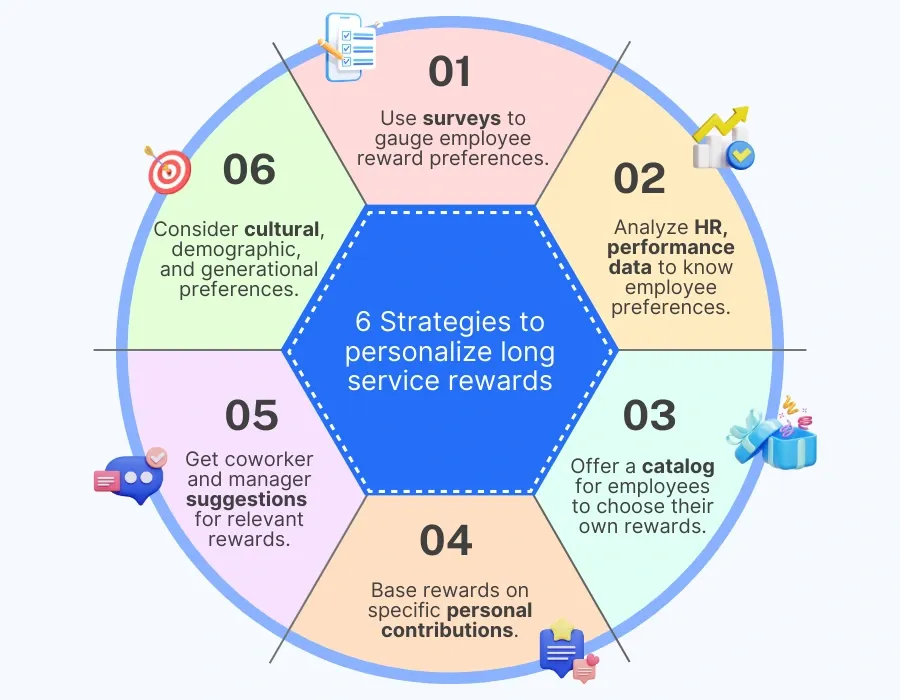
So how do companies nail this personalization thing? Well, it’s all about understanding the employee.
- Send surveys and feedback: This mechanism helps companies understand what kind of rewards would be most appreciated.
- Give a choice: Offering a range of options for employees to choose from can be a great way to personalize rewards. The sky's the limit, from experiences (like a spa day or adventure sports) to customized gadgets.
- Deliver memorable experiences: Often, it's not just about the physical reward. Creating a memorable experience – like a special award ceremony or a personal thank-you letter from the CEO – can add a huge personal touch.
The impact of sending personalized rewards
- Boosted morale: Personalization makes employees feel special and boosts morale.
- High retention rate: Personalized rewards can make employees feel valued and think twice before jumping ship.
- Positive company culture: This approach fosters a culture of appreciation and respect, which can attract top talent.
2. Experiential rewards will make it memorable
Experiences are becoming more popular than physical gifts. Think travel vouchers, spa days, concert tickets, or gourmet dining experiences. Experiences create lasting memories, which can be far more valuable than a physical item that might be forgotten in a drawer.
Example
- Weekend getaways: A relaxing weekend at a luxury resort or a charming bed and breakfast.
- Adventure experiences: Activities like hot air balloon rides, skydiving, or scuba diving lessons.
- Culinary experiences: Gourmet dining experiences, cooking classes with renowned chefs, or wine tasting tours.
- Wellness retreats: Spa retreats or wellness-focused vacations that focus on relaxation and rejuvenation.
- Cultural experiences: Tickets to Broadway shows, concerts, or access to exclusive art exhibitions.
Why there’s a shift towards experiential rewards
- To create memories: Experiences create stories and memories that last a lifetime. This is about giving employees something they can cherish way longer than any physical item.
- To personalize the max: Experiential rewards can be tailored to individual tastes and preferences. Love adventure? How about a skydiving experience! Prefer relaxation? A luxury spa weekend could be on the cards.
- To boost the 'feel-good' factor: Experiences have the power to boost happiness and well-being, more so than material possessions. It's about creating joy, not just giving a gift.
How to go about it
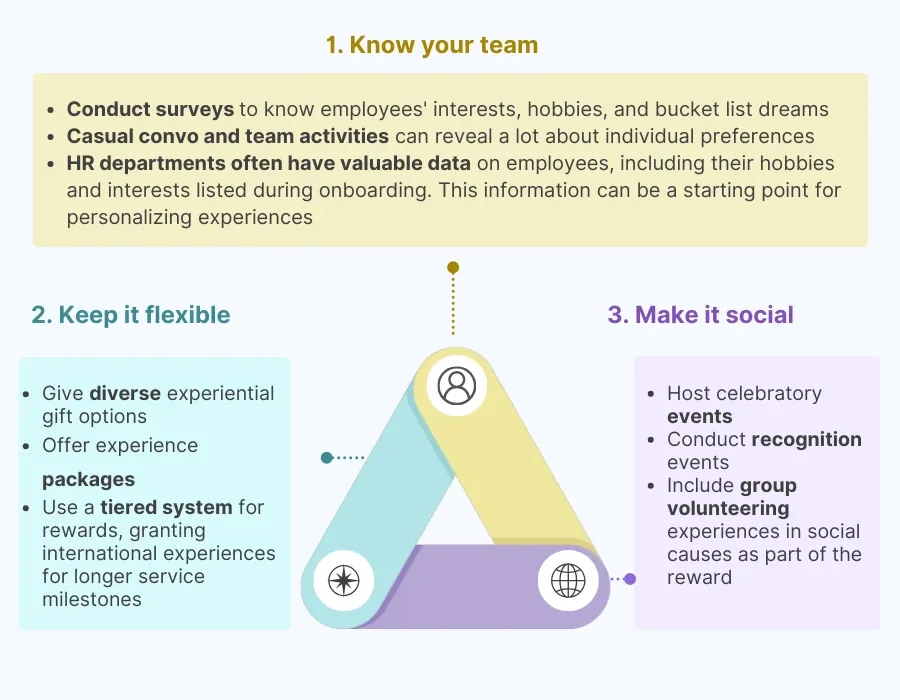
- Know your team: It starts with understanding what makes each employee tick. What are their hobbies? Their dreams? This insight can guide the choice of experiences.
- Flexibility is key: Offering a range of experiences to choose from ensures that there's something for everyone.
- Make it social: Some experiences are even better when shared. Think group outings or team-building retreats that double as long service rewards.
The impact of giving experiential rewards
- Lasting impression: Experiences can positively impact an employee's perception of the company, leading to a deeper emotional connection.
- Creates a buzz: These unique rewards become stories that employees share, boosting morale and creating a buzz in the workplace.
- Attract and retain talent: A company that offers unique experiential rewards stands out in the job market, attracting and retaining top talent.
3. Digital badges and rewards will revolutionize recognition
The trend of digital badges and rewards is more than just a fad; it’s a reflection of the evolving workplace. A digital badge is essentially an online representation of an achievement or skill. Think of it as a virtual trophy that lives on the internet.
These badges can be displayed on professional networking sites like LinkedIn, added to digital resumes, or showcased on internal company platforms.
Example
- Milestone anniversary badges: For instance, "Decade of Dedication" for 10 years, "Silver Service" for 25 years. These badges celebrate the number of years an employee has been with the company.
- Work anniversary rewards: — Online learning subscriptions like MasterClass, Udemy, or Coursera— For tech enthusiasts, give virtual reality gadgets or experiences— Subscriptions to meditation and wellness apps like Headspace or Calm— A catalog containing e-gift cards to enable employees to choose their rewards
Why digital badges and rewards are becoming a trend
- Instant recognition: Unlike traditional awards, digital badges can be awarded instantly. Achieved a milestone? Boom! Here's a badge. This immediacy boosts morale right away.
- Flexibility and scalability: Whether it’s a small team or a large corporation, digital badges and rewards can be easily scaled and customized. They fit perfectly into various corporate cultures and structures.
- Cost-effective: Let's face it, budgets matter. Digital badges cut down the costs associated with physical rewards. No need for expensive trophies or award ceremonies.
- Visibility and shareability: Digital badges can be shared on social media or professional platforms like LinkedIn. This not only boosts the employee’s morale but also enhances the company’s brand.
How to go about it
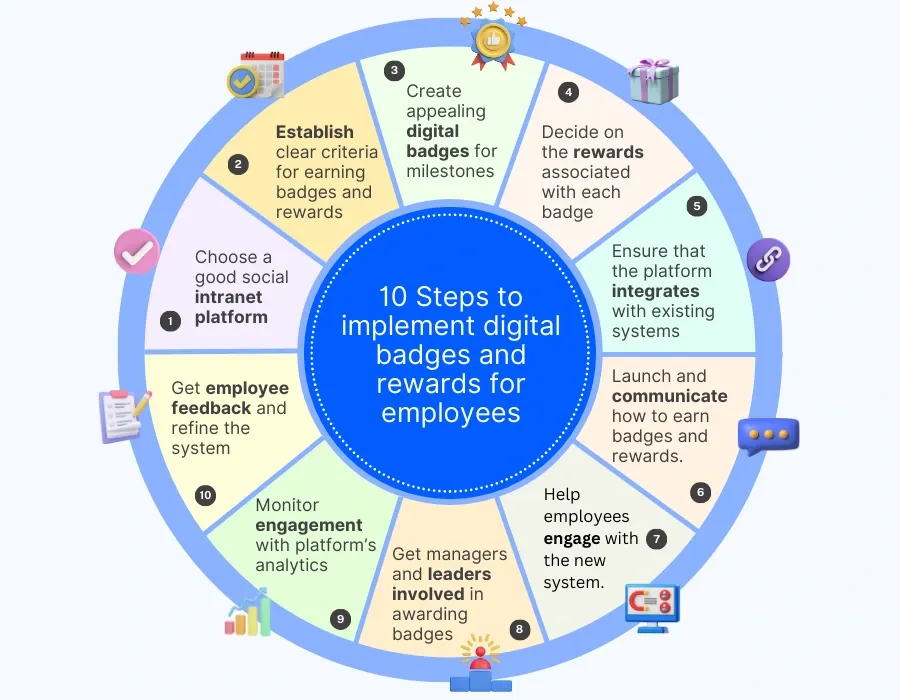
- Choose the right social intranet platform: Select a social intranet or employee engagement platform that supports digital badges and rewards. Ensure the platform is user-friendly and integrates well with existing company systems.
- Define badge criteria and rewards: Clearly define what actions or achievements will earn badges and rewards. These criteria should align with company values and goals. Examples include completing training modules, achieving sales targets, or demonstrating teamwork.
- Customize badges and rewards: Design badges that are visually appealing and represent different levels of achievement. Rewards can range from virtual recognition to tangible benefits like extra leave or gift vouchers.
- Reflect badges on employee profiles: Ensure that badges and rewards are displayed on employee profiles within the platform. This public recognition can boost morale and encourage others.
- Recognize and reward from your day-to-day tools: Select tools and software that easily integrate with your HRMS and communication platforms. Compatibility is key for a smooth workflow.
Once integrated, implement automated features for sending congratulatory messages for work anniversaries or achievements directly through the HRMS.
Incorporate a system where employees can choose their rewards, like redeeming points for gifts, experiences, or vouchers, through the HRMS. - Celebrate milestones: Use the platform to highlight and celebrate when employees reach significant milestones, such as earning a high-level badge or achieving a notable streak of accomplishments.
The impact of using digital badges and rewards
- Enhanced employee engagement: Digital badges make employees feel valued and recognized. This boosts their engagement and productivity.
- Talent attraction and retention: Companies using innovative recognition methods are seen as more attractive employers. This helps in both attracting new talent and retaining existing employees.
- Creates a positive work culture: Recognizing achievements through digital badges contributes to a positive and motivating work environment. It encourages a culture of appreciation and recognition.
4. Health and wellness perks will gain more traction
With a growing focus on well-being, rewards like gym memberships, wellness retreats, or subscriptions to meditation apps are becoming popular. These rewards show that the company cares about the employee's overall health and well-being, not just their work performance.
Example
- Premium gym memberships: Access to top-tier gyms or fitness clubs offering a range of wellness activities.
- Wellness retreats: Packages for wellness retreats focusing on relaxation, meditation, and rejuvenation.
- Health and wellness gift cards: E-gift cards for health and wellness stores or platforms, allowing employees to choose their preferred products or services.
- Healthy meal delivery services: Subscriptions to services that deliver healthy, nutritionally balanced meals.
- Online fitness class subscriptions: Access to virtual fitness classes or personal training sessions.
Why wellness perks are becoming a trend
- Beyond the office benefits: Offering health and wellness perks reflects a company’s commitment to its employees' overall well-being, not just their professional achievements.
- Tailored to individual needs: These perks can be incredibly diverse – from gym memberships and yoga classes to mental health support and nutritional counseling. There’s something beneficial for everyone.
- A nod to modern lifestyle challenges: Recognizing the stresses of modern life, these perks show that a company understands and supports the need for balance and self-care.
How to go about it
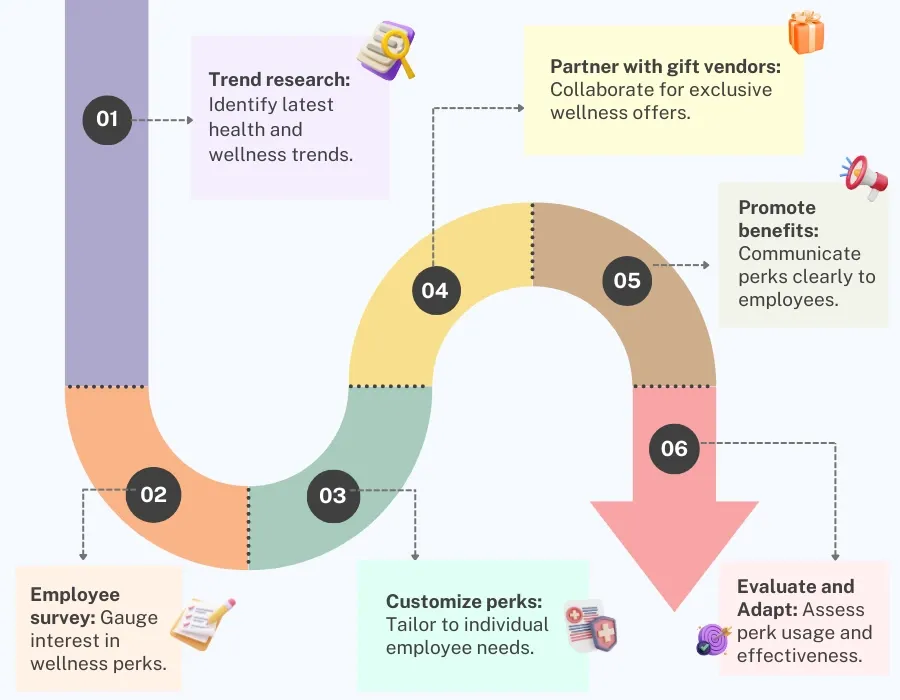
- Research the latest trends: Stay updated with the latest health and wellness trends, such as mindfulness apps, fitness wearables, or wellness retreats.
- Survey employee interests: Conduct short surveys to understand what health and wellness perks your long-tenured employees are interested in.
- Customize offerings: Tailor perks to meet the specific interests and needs of long-tenured employees, considering their age, lifestyle, and health preferences.
- Partner with wellness providers: Collaborate with gyms, wellness app companies, or health professionals to provide exclusive offers or services.
- Educate and promote: Clearly communicate the benefits of these perks and how employees can access them, using internal communication channels.
- Monitor and evaluate: Regularly assess the usage and effectiveness of these perks and gather employee feedback for continuous improvement.
The impact of offering better health and wellness perks
- High employee morale: Healthy employees are happier and more productive. When employees feel good physically and mentally, it reflects in their work.
- Enhances company image: Companies that prioritizes health and wellness are seen as caring and forward-thinking. This boosts its reputation in the job market.
- Low healthcare costs: Over time, these perks can lead to healthier employees, which might mean fewer sick days and lower healthcare costs.
5. Gamification of rewards to keep things fun and exciting
Gamification in the workplace is like adding a pinch of excitement to the usual routine. It turns the traditional approach to recognition on its head by infusing elements of play, competition, and achievement into the mix. And when it comes to honoring those who have stuck around for the long haul, it brings a fresh and engaging twist.
Example
- Virtual rewards and recognition platforms: These platforms can host virtual celebrations, leaderboards, and display badges or trophies that employees earn overtime. It makes the recognition visible and celebrated company-wide.
- Point-based system: Employees earn points for each year of service or for achieving specific milestones. These points can then be redeemed for various rewards, either from your HRMS or intranet platform, allowing for a more personalized and engaging experience.
- Tiered achievement levels: Similar to levels in a game, employees can reach different 'tiers' or 'stages' based on their tenure. Each level unlocks unique rewards or privileges, providing a sense of progression and achievement.
- Interactive quizzes, challenges, and competitions: Encourage employees to participate in friendly competitions or challenges with rewards for winners or top performers. These can be linked to work anniversaries or milestones.
Why reward gamification is a trend
- Continuous motivation and participation: Unlike annual awards, gamification allows for continuous recognition. This ongoing process keeps employees consistently engaged and motivated throughout the year, rather than just at the time of the award ceremony.
- Social recognition: Many gamified platforms have social features that allow peers to recognize each other’s achievements. This not only increases visibility but also fosters a sense of community and teamwork within the organization.
- Adapts to modern workforce: Millennials and Gen Z have grown up with gaming as a part of their lives. Gamification speaks their language, making recognition more relatable and effective for a significant portion of the employee base.
How to go about it
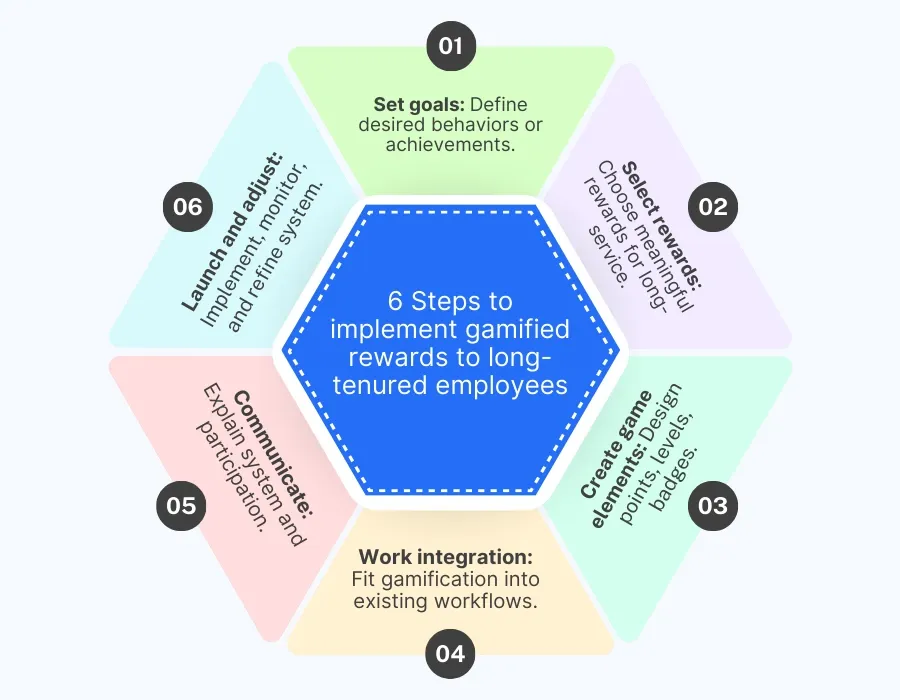
- Identify Goals: Define what behaviors or achievements you want to encourage with gamified rewards.
- Choose reward types: Select rewards that are meaningful to long-tenured employees, such as exclusive experiences, advanced training opportunities, or additional time off.
- Design gamification elements: Create elements like points, levels, and badges that employees can earn for various achievements.
- Integrate with work processes: Ensure the reward gamification system fits seamlessly into existing work processes and platforms.
- Communicate clearly: Explain how the system works, its benefits, and how employees can participate and earn rewards.
- Launch and monitor: Implement the system, monitor its usage and impact, and make adjustments based on feedback and results.
The impact of introducing gamified rewards
- Enhanced employee loyalty: Innovative recognition methods, like gamification, can increase employee loyalty, particularly among long-tenured staff who have seen it all.
- Personalization: Gamification adds a layer of personalization that’s highly valued in modern workplaces.
- Attracts new talent: A company that uses modern, engaging methods like gamification stands out in the job market, attracting innovative and dynamic talent.
Wrapping up
As we wrap up our exploration into the evolving world of long service awards, it's clear that we're witnessing a remarkable shift in how employee loyalty and dedication are recognized and celebrated.
These awards are no longer just about commemorating tenure; they've transformed into meaningful expressions of appreciation that deeply resonate with employees.


